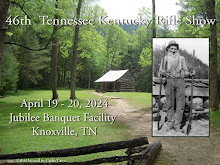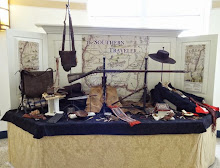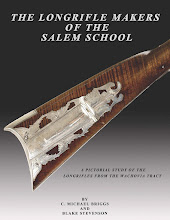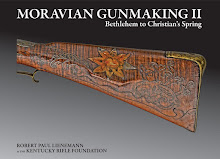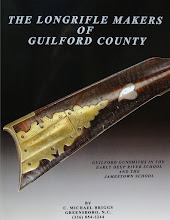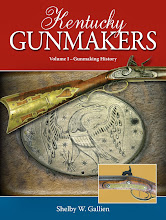Sunday, November 30, 2008
Saturday, November 29, 2008
Tom Curran
 This is a real dagger, though it’s only 3 1/4″ long. The blade is hardened high carbon steel. The grip is horn, the guard and pommel are sterling silver. The sheath is formed steel, very thin, silver soldered together. This is a close copy of an 18th Century dagger. Used for self protection or intrigue, the dagger and sword were part of daily dress. The original has a 6″blade.
This is a real dagger, though it’s only 3 1/4″ long. The blade is hardened high carbon steel. The grip is horn, the guard and pommel are sterling silver. The sheath is formed steel, very thin, silver soldered together. This is a close copy of an 18th Century dagger. Used for self protection or intrigue, the dagger and sword were part of daily dress. The original has a 6″blade. The sheath has a retainer clip to keep the blade in place when not in use.
The sheath has a retainer clip to keep the blade in place when not in use. Tools are an integral part of what I do; they are extension of my hand, and yes, of my brain. Each and every tool of humankind was created for a specific use. Some tools are quite beautiful, and these are the ones that appeal to me. Some are weapons, while others are simply tools.
Tools are an integral part of what I do; they are extension of my hand, and yes, of my brain. Each and every tool of humankind was created for a specific use. Some tools are quite beautiful, and these are the ones that appeal to me. Some are weapons, while others are simply tools.Axes are definitely weapons, though their roots go back to simple tools for working wood. I was at the Metropolitan Museum a couple of weeks ago, and saw their collection of Greek and Roman artifacts. In the cases with Greek pottery shards and jewelry I spied some miniature double bitted axes, similar to the one below, hence the inspiration. This axe has a sterling chain and clasp.
 This axe represents an American pipe tomahawk, from the 18th Century Colonial period, used for ceremonial purposes. Shown alongside a worn out English George III penny. Linen cord with sterling clasp.
This axe represents an American pipe tomahawk, from the 18th Century Colonial period, used for ceremonial purposes. Shown alongside a worn out English George III penny. Linen cord with sterling clasp.These I made from steel, with wooden handles. They will rust, getting more realistic with time and wear. The handles are Brazilwood, or pernambuco, a wood used for making violin bows and for making a red dye in the 18th Century. The handles are riveted through the axe heads to make a permanent fastening, without the use of any glues or adhesives.
Each axe is approximately 2 1/2″ tall, entirely handcrafted, a one of a kind object.
The edges are not sharp, they are just polished to look that way. T.C.
Photos supplied by Tom Curran.
Friday, November 28, 2008
John Borgeson Knife Sheath
The sheath is made from braintan heavy smoke deer and sewn with buffalo sinew and glass beads. It closely copies and original in the Cody Museum collection.
Photos supplied by John Boreson.
Thursday, November 27, 2008
O Beautiful for Spacious Skies
For amber waves of grain,
For purple mountain majesties
Above the fruited plain...
Photos supplied by Scott and Cathy Sibley.
Wednesday, November 26, 2008
"Rivers of the Frontier" Series Pouches by T.C. Albert
This pouch, named "The Apalachicola", was made for Mr.James Levy of Florida. He wanted an early styled pouch with a Native American influence like something that could have been used in his home state in the 18th century.
The hand made powder horn is buffalo, and is quite likely to have accompanied such an early set from this region, as buffalo were in fact found in Florida at that time. Its simply constructed and hung by its own leather strap with adjusting buckle.
The aged leather pouch has a very pointed drop flap, is decorated at each edge with a brass cone embelished with a single glass bead. The strap is reminiscent of the traditional "Bandolier" bags made famous by the Natives of the south east with its swallow tailed extensions, and is buttoned to the back of the pouch by a pair of early styled brass buttons bearing a martial coat of arms.
The engraved powder measure is made from a very large alligator tooth that has been scrimshawed and fitted with a swivel at the tip for the attachment of the lanyad cord. The engraving on the measure is patterned after the engraving of "The Long Warrior" or King o the Creeks by Wm. Bartrum, and depicts a famous warrior chief from the very area this set is made to pay tribute to, the Apalachicola River of southern Florida. T.C.A.
Photos by Mr. Roy Lett.
The hand made powder horn is buffalo, and is quite likely to have accompanied such an early set from this region, as buffalo were in fact found in Florida at that time. Its simply constructed and hung by its own leather strap with adjusting buckle.
The aged leather pouch has a very pointed drop flap, is decorated at each edge with a brass cone embelished with a single glass bead. The strap is reminiscent of the traditional "Bandolier" bags made famous by the Natives of the south east with its swallow tailed extensions, and is buttoned to the back of the pouch by a pair of early styled brass buttons bearing a martial coat of arms.
The engraved powder measure is made from a very large alligator tooth that has been scrimshawed and fitted with a swivel at the tip for the attachment of the lanyad cord. The engraving on the measure is patterned after the engraving of "The Long Warrior" or King o the Creeks by Wm. Bartrum, and depicts a famous warrior chief from the very area this set is made to pay tribute to, the Apalachicola River of southern Florida. T.C.A.
Photos by Mr. Roy Lett.
Tuesday, November 25, 2008
Subscribe to:
Posts (Atom)
















































